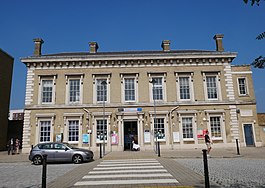| Greenwich | |
|---|---|
 Main station entrance | |
| Location | Greenwich |
| Local authority | Royal Borough of Greenwich |
| Managed by | Southeastern Docklands Light Railway |
| Owner | Network Rail Transport for London |
| Station code(s) | GNW |
| DfT category | D |
| Number of platforms | 4 |
| Accessible | Yes[1][2] |
| Fare zone | 2 and 3 |
| DLR annual boardings and alightings | |
| 2019 | |
| 2020 | |
| 2021 | |
| 2022 | |
| 2023 | |
| National Rail annual entry and exit | |
| 2018–19 | |
| 2019–20 | |
| 2020–21 | |
| 2021–22 | |
| 2022–23 | |
| Key dates | |
| 24 December 1838 | Opened |
| 12 April 1840 | Resited |
| 11 January 1878 | Resited[9] |
| 20 November 1999 | DLR extension |
| Other information | |
| External links | |
| Coordinates | 51°28′41″N 0°00′50″W / 51.4781°N 0.014°W |
Greenwich station is about 400 m south-west of the district centre, in London, England. It is an interchange between National Rail between central London and Dartford (north Kent), and the Docklands Light Railway (DLR) between Lewisham to the south and Docklands and the City of London. It is in Travelcard Zones 2 and 3.
It is the nearest National Rail station to the centre of Greenwich, but Cutty Sark for Maritime Greenwich DLR station is closer to the town centre and its tourist attractions.
East of the station the Dartford line goes through a tunnel underneath the grounds of the National Maritime Museum, towards Maze Hill. Northwards, the DLR goes into a tunnel through Cutty Sark station and under the River Thames to the Isle of Dogs; in the opposite direction, it rises on a concrete viaduct to follow the River Ravensbourne upstream to Deptford Bridge and Lewisham.
On the National Rail network, Greenwich is 3 miles 47 chains (5.8 km) measured from London Bridge.
- ^ "Step free Tube Guide" (PDF). Transport for London. April 2021. Archived (PDF) from the original on 15 May 2021.
- ^ "London and South East" (PDF). National Rail. September 2006. Archived from the original (PDF) on 6 March 2009.
- ^ "Station Usage Data" (XLSX). Usage Statistics for London Stations, 2019. Transport for London. 23 September 2020. Retrieved 9 January 2022.
- ^ "Station Usage Data" (XLSX). Usage Statistics for London Stations, 2020. Transport for London. 16 April 2021. Retrieved 9 January 2022.
- ^ "Station Usage Data" (XLSX). Usage Statistics for London Stations, 2021. Transport for London. 12 July 2022. Retrieved 7 September 2022.
- ^ "Station Usage Data" (XLSX). Usage Statistics for London Stations, 2022. Transport for London. 4 October 2023. Retrieved 20 October 2023.
- ^ "Station Usage Data" (XLSX). Usage Statistics for London Stations, 2023. Transport for London. 8 August 2024. Retrieved 16 September 2024.
- ^ a b c d e "Estimates of station usage". Rail statistics. Office of Rail Regulation. Please note: Some methodology may vary year on year.
- ^ Butt, R.V.J. (1995). The Directory of Railway Stations. Sparkford: Patrick Stephens Ltd. p. 109. ISBN 1-85260-508-1.
